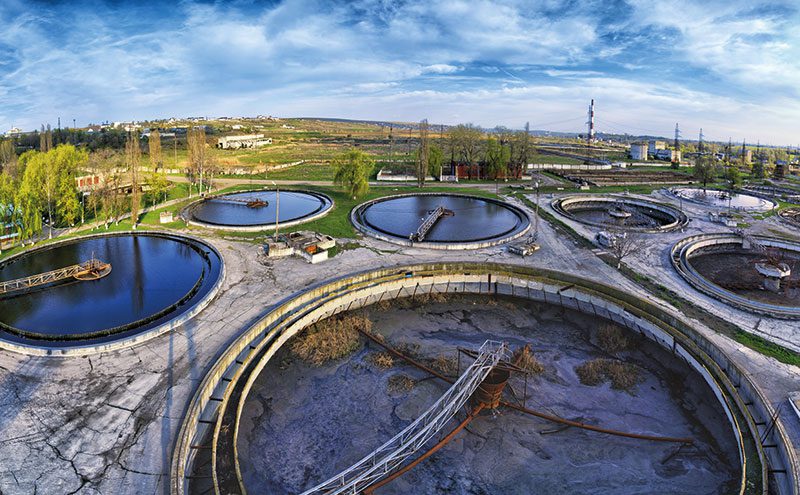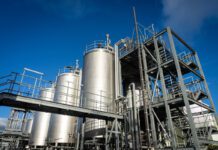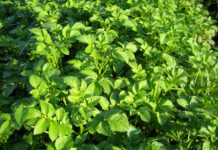A municipal wastewater treatment method should be cost effective, easy to operate and do the job. Anaerobic forms of biological treatment appear to score highly, but there are downsides too. A panel session at July’s AD & Biogas show explored some of the trade-offs involved in their selection, and efficiency challenges facing plant operators.

Fast forward through the past few decades and you see a trend towards more and more sewage sludge ending up on the land for agriculture purposes, rather than being dumped. The opening presentation by Alison Fergusson of OFWAT favoured the term ‘bioresources’ over ‘sewage sludge’, as if to acknowledge how far that shift in thinking has progressed.
Going back to 1991 about half the sludge generated went onto farmland, not necessarily in the form of digested sludge, a lot of it had simply been treated with lime. At the same time about 22% of it was dumped at sea, before this practice was outlawed by EU Directives in around 1998. By 2000, the amount going to agriculture had increased further while 22% went to incineration, and some went to landfill. Go forward another 10 years, and by 2010 around 79% of it was going to agriculture, 18% to incineration, and not much to landfill, since the landfill tax had been introduced by this time.
The past six or seven years have seen a continuation of these trends, she said, and a huge increase in the amount of sludge going to AD, including ‘advanced’ AD (using hydrolysis or other advanced processes). There has also been a sharp decrease in the use of liming and incineration. So the direction of travel is clearly ‘more energy’ and ‘more product for the land’.
But there’s a way to go yet, and Fergusson’s opening address clearly anticipated a potentially transformative step change in the efficiency with which sewage sludge, or bioresources, can be handled. At the moment, companies are very inwardly focused, and with the status quo we might expect ongoing incremental improvements, as firms optimise the handling of sewage in-house, and optimise things like transport costs. “What we’re trying to do, moving forward, is actually break open what happens with sewage sludge,” said Fergusson.
Part of OFWAT’s planned deregulation of the water sector, set to come into effect in 2020, is the introduction of open markets for sludge. This departs from the traditional model where sewage sludge is dealt with by a water utility or sewage company. Maybe it could be handed instead to a different kind of firm, one with a novel technology, or maybe a commercial waste company. “We’re really hoping that by promoting markets we’ll encourage trading between companies, and trading across organic waste and water company boundaries,” said Fergusson. And in doing so, she said, “we’ll actually see some improvements in resilience – if more people are involved in this activity, it will become a more resilient process”.
Information is an important currency here. Where is the sludge? What is its quality and quantity? This kind of information is going to be made publically available, she said, for the benefit of “anyone out there who wants to get their hands on it, and treat it and deal with it”.
OFWAT published a document in 2016 outlining its plans to create open markets for sludge, and has already done some consultation on how to attempt the sort of information provision just outlined. In July, she said, it would be consulting on the ‘what’ and ‘how’ aspects of regulating the water industry in this way. “We think there’s going to be considerable benefits for customers, companies and the environment,” she said.

Blanket coverage
Listening to Fergusson’s talk, with its focus on improving the efficiency of the sewage infrastructure in a country where it is already well established, it was easy to forget that in fact sewage treatment is something of a luxury in many parts of the world, unavailable to most of the population.
In the presentation which followed, Dr César Mota, a Brazilian wastewater expert based at the Universidade Federal de Minas Gerais, provided an overview of his own country’s situation, and particularly its preference for Upflow Anaerobic Sludge Blanket (UASB) reactors.
His country’s situation is interesting, he said, “because the deficits are still huge”. It’s a nation of 200 million people but only 40% of the population has access to wastewater treatment. The environmental health impacts of this shortfall were gruesomely illustrated via a couple of slides and photography showing the effects of intestinal parasites and the like. “Traditionally the affected people are poor,” he said, “so people don’t care. But that’s changing too.” The alarming speed with which the ZIKA virus has taken hold in Brazil may be fomenting a change in infrastructure priorities, he mused, since “mosquitoes that proliferate in these conditions don’t choose if you are poor or rich”.
Whatever treatment technology you select, he said, it must be cheap and easy to operate, and do the job. But there are many ways to do the job. It’s a decision not to be taken lightly, since whoever operates it will have to live with it for 30 or 40 years.
He offered an overview of treatment methods popular in Latin America, and recent data on how it breaks down by country and technology. Wastewater treatment sites in the region mostly use stabilisation ponds (38%) and UASB reactors (17%), although activated sludge is also quite popular, particularly in Chile where “pretty much all” sites use it. The technology most popular in the US and Europe, activated sludge treats wastewater to a very high standard, and is quite compact. But, as he said, “it is very, very expensive”. It requires a lot of electricity and also produces a lot of biosolids, and dealing with the latter carries a high cost. “For Brazil it’s not the best option,” he said, suggesting he didn’t think it the best for Chile either.
UASB vs activated sludge
Activated sludge is being used in large urban areas in Brazil, like Sao Paulo and Rio de Janeiro, as there are the scales to make it favourable, and where land constraints would complicate the introduction of other techniques.
UASB is a popular method in low to middle income countries, and also those with a warm or favourable climate. As such it is the most popular wastewater treatment method in Brazil, followed by stabilisation ponds. Its popularity is down to the climate, said Mota, but also there is a strong research base, including the centre where he works in Belo Horizonte, which also hosts the world’s largest UASB reactor at the Onca Sewage Treatment Plant, which treats the waste for over one million people. The site seemingly uses a combination of UASB reactors, trickling filters and secondary clarifiers.
The advantages of UASB include its cheapness to build and operate, the fact that it doesn’t use high tech equipment, and its compactness and robustness. It also doesn’t produce very much sludge compared to activated sludge, and the sludge can be reused, or you can harvest the nutrients from it, “because this technology doesn’t do much with the nutrients, you don’t lose them”, although this obviously requires post-treatment. Downsides or constraints associated with the method include methane losses in the effluent, because 20-50% of the methane can be in the liquid phase. There are also issues with odour and dissolved hydrogen sulphide, and there is a need for scum management, which usually requires a lot of treatment. There is so far very little experience of using UASB in low and medium temperature climates, he said, “but I don’t think it’s impossible – it needs more research.”
In terms of flow rate, activated sludge obviously beats all the others. However, with UASB, he quoted 14 cubic litres per second as a figure demonstrated with a reactor at his own facility.
Phosphorus: A benign foe?

Wastewater plants are potentially a source of phosphorus pollution, an urgent issue for many operators given increasingly tight regulation, and this provided the focus for the next speaker, Dr Ana Lanham, a lecturer in water science and engineering at the University of Bath.
One of the things she liked about phosphorus, she said, was that it wasn’t a “bad pollutant” as such – its presence could at times be seen as “too much of a good thing”. It’s indispensable for life and agriculture, but it also produces problems when it leaks into waterways, such as eutrophication – the algal blooms that deny oxygen to other marine life. So there’s a balance to be found.
Most phosphorus that ends up in waterways comes from agricultural run-off, although wastewater plants can be sources of it – indeed, these are the only concentrated sources of phosphorus.
As Lanham explained, phosphorus (and nitrogen) flows to the ocean and biosphere is one of the nine planetary boundaries adopted by the UN as offering important signposts for global sustainability, And the problem of phosphorus being released into the sea with sewage appears in popular culture as early as 1928, in the narrative of Aldous Huxley’s novel Point Counter Point, where the character Lord Edward inveighs against the irresponsibility of the practice.
Constraints on phosphorus discharge have followed a steady downward curve in recent years: EU WFD limits are 1-2mg per litre, while the figures for AMP6 and AMP7 are 0.5mg per litre and 0.1mg per litre, respectively. So it’s a priority for wastewater plant operators.
Most of the UK wastewater industry deals with it by adding iron, aluminium or lime to the water. These additives precipitate phosphorus, and these precipitates can be removed with the sludge during the treatment process.
Chemical precipitation is one of two strands of phosphorus removal methods commonly used – the other being biological processes, which use bacteria to facilitate the uptake of phosphorus into a microbial cell, which allows it to be separated from the wastewater and taken off with the sludge. Typically, said Lanham, plants will use a combination of these two methods. So a conventional activated sludge plant will have an anaerobic stage added, and by alternating the bacteria between these anaerobic and aerobic stages you are selecting for a group of organisms that can actually do this phosphorus uptake
If phosphorus is removed during a secondary stage of treatment, the solids generated will go into your anaerobic digester, along with any solids generated during the primary stage. So there are important implications for the AD stage, and the biological processes running therein, if you plan on suddenly improving your facility to remove phosphorus at an earlier point. Lanham presented a slide on recent academic studies, and listed some of the implications they highlight. For example, you might be changing your sludge properties which changes your capacity to thicken or dewater that sludge. Also, you might be having secondary release phosphorus in your digester, or prior to going into your digester. Or you might be affecting your gas yields, as iron or aluminium might change the nutrient capacity in your digester. You might be changing your sludge digestability. You might be changing completely your inorganic profiles across the whole system in terms of the amounts of things like iron, aluminium, calcium, and phosphate – but also things like magnesium which are essential to biological processes.
“You are changing potentially the quality of your biosolids. In the end you might have restrictions on the quantities of iron or aluminium that you can discharge with your biosolids, and you are impacting also on the potential for phosphorus recovery in terms of whether you choose chemical precipitation or a biological phosphorus removal strategy,” she said.
These are just some of the implications, she said, adding: “I don’t know the answer to many of these”.
It’s an issue to take into account when attending conferences like these, she said. Very often we focus on different technologies in a piecemeal fashion, sometimes neglecting the holistic picture. While Fergusson’s presentation suggested a general trend towards breaking open the silos that deal with sludge and considering it as a set of discrete markets, it was also “important to have the notion that if you change something upstream that will have consequences downstream”.






